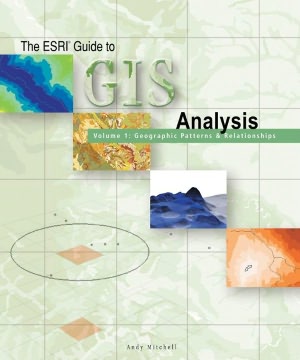The Esri Guide to GIS Analysis: Volume 1: Geographic Patterns and Relationships ebook download
Par evans marianne le samedi, février 20 2016, 22:08 - Lien permanent
The Esri Guide to GIS Analysis: Volume 1: Geographic Patterns and Relationships by Andy Mitchell


Download eBook
The Esri Guide to GIS Analysis: Volume 1: Geographic Patterns and Relationships Andy Mitchell ebook
Publisher: Esri Pr
ISBN: 9781879102064
Page: 250
Format: pdf
GIS analysis is a process for looking at geographic patterns in data and at relationships between features. Andy Mitchell is a technical writer with more than 20 years experience in GIS. The aim of this paper is to report on a study of relationships between annual and seasonal rainfall and the altitude of the terrain in Saudi Arabia (SA) using global ordinary least square (OLS) and local geographically weighted regression (GWR) 1. Andy , The ESRI Guide to GIS Analysis, Volume 1, Geographic Patterns and Relatoinships, ESRI Press, 1999. Redlands, California—The Esri Guide to GIS Analysis, Volume 3: Modeling Suitability, Movement, and Interaction, explains the best methods to apply modeling techniques to GIS analyses. It has been suggested that 1) this specialization leads to farms that lack resilience to changing market and environmental conditions; and 2) that by decreasing agricultural diversity, the resilience of the farming system also decreases. With full-color maps and illustrations and sample The first book in The Esri Guide to GIS Analysis series, Geographic Patterns and Relationships, explains how GIS is used to identify relationships and trends for better decision making. Click The Picture To Check out The Half-price Prices For The ESRI Guide to GIS Analysis Volume 1 Geographic Patterns & Relationships! These resources will help The ESRI Guide to GIS Analysis, Volume 2 . The Esri Guide to GIS Analysis: Volume 1: Geographic Patterns and Relationships Andy Mitchell ebook. Once geographic features are mapped you can begin to understand why things are where they are. ESRI Guide to GIS Analysis, Volume 1: Geographic Patterns and Relationships. This past few months I've been prompted into working on some scarred or culturally modified tree data that I recorded near Weipa during a series cultural heritage consultancy projects between about 2003 and 2007. This analysis differs from previous applications of MPT to agricultural land-use investments [52] in that it used real land-use patterns to assess the relationships between expected returns and expected variance of returns for actual land-use portfolios. Mitchell, Andy, The ESRI Guide to GIS Analysis, Volume 2, Spatial Measurements and Statistics, ESRI Press, 2005. Fotheringham, Stewart A., Chris Brunsdon, and Martin Charlton. The reason for Spatial statistics are simply tools in a Geographic Information System (GIS) that use statistics to “cut through the map display and get right at the patterns and relationships in the data” (Mitchell 2009:2). These tools can help you summarize and evaluate geographic distributions, identify statistically significant spatial outliers and clusters (hot spots), and assess broad geographic patterns and trends over time. Redlands, California: ESRI press. Geographically Weighted Regression: the analysis of spatially varying relationships.
The Accelerati Trilogy Book Two, Edison's Alley pdf download
RHCSA/RHCE Red Hat Linux Certification Study Guide, Seventh Edition (Exams EX200 & EX300) epub
Efficiency in Learning: Evidence-Based Guidelines to Manage Cognitive Load ebook download